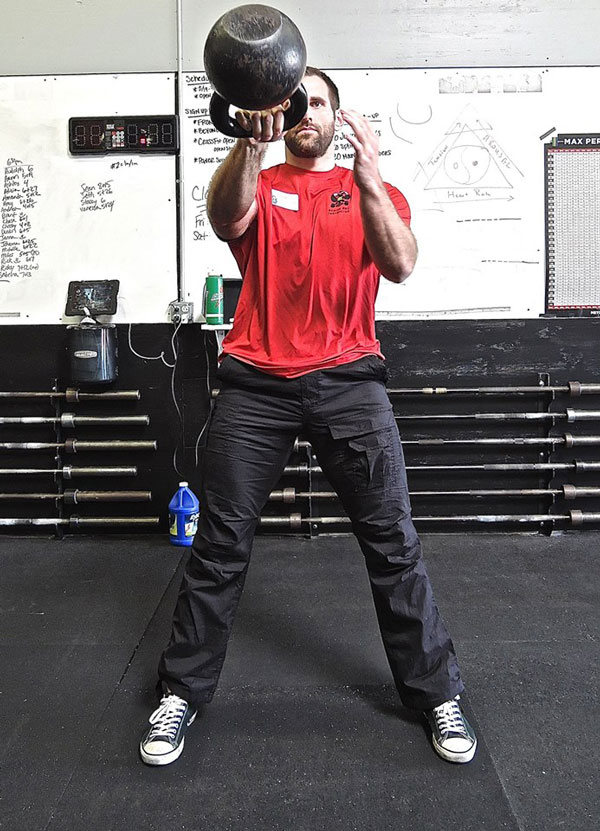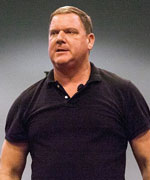The Whats, Whys and Hows of Successful Programming, Part II
By Dan John, Master RKC
Let’s look at the most common work to rest ratios:
1:1
This ratio can be difficult. Generally, this is 30 seconds on then 30 seconds rest (or active recovery). If we are doing kettlebell swings, you will swing for 30 seconds and then do "Fast & Loose" drills for 30 seconds.
For many trainees, using shorter time intervals is an issue. 15 seconds on and 15 seconds off often requires a level of skill and precision that many people simply don’t have…yet.
Practiced with a partner, the 1:1 ratio method is known as "I go/you go."
1:2
This is the work to rest ratio we use in "cohorts." Cohorts are three person groups training together. The rest period increases by the addition of another person. "I go/you go/you go." For exercises that need more recovery—double
kettlebell front squats for example—the 1:2 ratio gives the body time to recover before performing another set.
1:3
This ratio is how I learned to lift. We worked in groups of four and everyone took their turn. The 1:3 ratio is very good for grinds, Olympic lifts and powerlifts in group and team settings.
Tabata
This pattern is twenty seconds of movement followed by ten seconds of rest repeated for a total of four minutes. I think Tabata works with squats and honestly, nothing else. It is a workout that leaves people in a pool of sweat while their dog tries to call 9-1-1…without thumbs! Tabata is a
popular workout that has been so bastardized that its original vision has been lost. Use it with common sense.
Density Training
Density training probably makes for the best kettlebell workouts. Doing the same workload in less time works well with kettlebell ballistics and workout complexes like double kettlebell clean and push jerks. I would suggest using heavier kettlebells, or
changing the workout after completing five workouts where the same workload is completed in less and less time. But, as good as density can be, enough is enough.
Specialized Variety
Specialized variety can be summed up in two ways:
- "Same, but different"
- "Fun"
Pat Flynn’s other two principles apply here: "Add variety for plateaus" and "Randomness for fun."
Most people who have trained for a while know the basics. If we’re training with barbells, we might switch out front squats for back squats, or the incline bench press for bench press. When Dick Notmeyer had me do back squats after four years (!!!) of just front squats, I felt like a new man. It was basically the same thing, but it was actually fun.

If you are bored with two hand kettlebell swings, shift to one arm—or do double kettlebell swings, or dead stop swings, or…
The
HKC,
RKC and
RKC II manuals have multiple pages devoted to examples of different moves and variations for every basic movement.
But…
Specialized variety is not just for fun or an attempt to deal with boredom. Biology teaches us that we adapt to stress and stimulus. We learn to accommodate (the law of accommodation) and improve at a task with less and less effort.
For body composition training, which is usually fat loss, we need to use the concept of "inefficient exercise." Simply, if you are really good at something, you probably won’t stress your fat reserves doing that movement.
If you were a former collegiate swimmer and put on fifty pounds of fat, swimming—especially now that you are more buoyant—might not be a good fat loss option for you. You are too talented (and floaty) to be sufficiently challenged by swimming laps.
Here’s another example, I have a neighbor who has a tricked out racing bike, aerodynamic helmet, and, yes, a white spandex racing suit. White.... as in "almost see through." He also has a magnificent beer belly. His problem is simple. His bike rolls effortlessly around our streets and he doesn’t need to work very hard to get in all his miles.
My bike is a cruiser. It weighs about seventy pounds and has a built-in bottle opener. It’s a struggle to peddle my bike up a small incline. Riding one hundred miles on this big tire, beer-holding bike would take a lot of effort!
If you can’t swim well, struggling back and forth in a pool is a great workout. If you float and glide, it might not be much of a day.
Inefficient exercise drives fat loss.
When you get too good at certain moves, even though you might drive the reps up, you still might not increase the energy usage. One of the things we notice in "The 10,000 Swing Challenge" is that towards the end, we have figured ways to save energy. We have learned to "cheat" the swing. We become "efficient."
So, we need to change the exercise with specialized variety. We will still do the basic movement, but will choose a different variation.
 Master RKC, Dan John is the author of numerous fitness titles including the best selling
Master RKC, Dan John is the author of numerous fitness titles including the best selling Never Let Go
and Easy Strength. Dan has spent his life with one foot in the world of lifting and throwing, and the other foot in academia. An All-American discus thrower, Dan has also competed at the highest levels of Olympic lifting, Highland Games and the Weight Pentathlon, an event in which he holds the American record.
Dan spends his work life blending weekly workshops and lectures with full-time writing, and is also an online religious studies instructor for Columbia College of Missouri. As a Fulbright Scholar, he toured the Middle East exploring the foundations of religious education systems. For more information visit DanJohn.net
Back